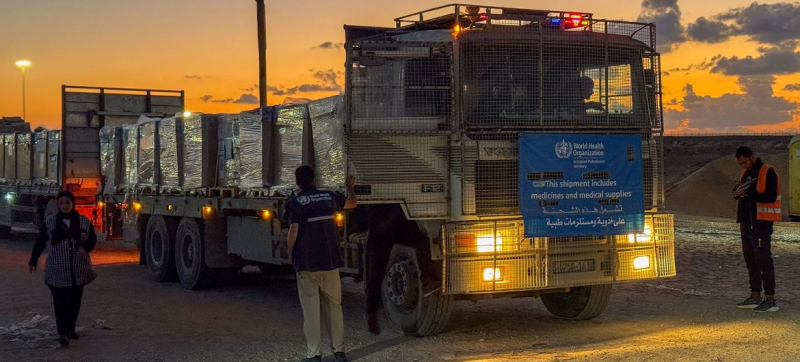- St Martin’s reopens, but no ships sail as overnight stays banned |
- Chief Adviser directs armed forces to prepare for election security |
- After rain ‘Moderate’ air quality recorded in Dhaka on Sunday |
- Dealers blamed for artificial fertiliser shortage in Rangpur |
- At Least 50 Dead as Caribbean Recovers from Hurricane Melissa |
WFP Warns of ‘Overwhelming’ Food Aid Demand as Gaza Ceasefire Holds

A truck carrying aid passes through the Kerem Shalom crossing into Gaza.
In Gaza, the ceasefire is allowing UN humanitarians to reach more desperate people with life-saving food assistance — but greater access is still needed to curb the spread of famine.
Abeer Etefa, Senior Regional Communications Officer for the World Food Programme (WFP), told reporters in Geneva on Tuesday that since the ceasefire began on 11 October, the agency has brought in over 6,700 metric tonnes of food — enough for nearly half a million people for two weeks.
“Daily deliveries continue, now averaging around 750 tonnes,” Ms. Etefa said. “That’s much better than before the ceasefire, but it’s still far below our target of around 2,000 tonnes a day.”
She explained that reaching this goal is “almost impossible” unless all border crossing points are opened.
Crossing challenges
Currently, only the Kerem Shalom and Kissufim crossings in the south are open. Severe destruction continues to impede access from the south to the north, where famine was declared in August.
“We need Erez, we need Zikkim — we need these border crossing points to open,” Ms. Etefa urged, stressing that reaching northern Gaza with large-scale convoys is a top priority.
“We’ve cleared the roads at scale into the north,” she added, noting that debris had been removed from border areas to reconnect Gaza City, where conditions are especially dire. “But we need these crossings open so that we can send large convoys.”
Restoring food distribution
WFP has begun restoring its food distribution system, aiming to scale up assistance through 145 distribution points across the Gaza Strip. So far, 26 have been reinstated.
“The response has been really overwhelming,” Ms. Etefa said, describing people’s reactions. “People are showing up in large numbers, grateful for the efficiency of the food delivery and the dignified way they can queue and receive their rations.”
She said the impact has been significant, particularly for “the most vulnerable — women, female-headed households, and the elderly.”
Fragile optimism
While people remain hopeful, there is only “cautious optimism” about how long the current conditions will last. Many are rationing their food supplies, uncertain how long the ceasefire will hold.
“It is a fragile peace,” Ms. Etefa stressed.
Adding to the challenges, food prices in Gaza remain prohibitively high, and supplies are still insufficient. “People can find food in the market, but it’s out of reach because it’s extremely expensive,” she warned.
Support for the starving
WFP is assisting the most food-insecure people through digital payments, enabling about 140,000 people to buy food from local markets. The agency aims to double that number in the coming weeks.
Ms. Etefa reiterated calls for commercial supplies to enter Gaza and supplement humanitarian aid. “Aid alone cannot solve severe malnutrition or provide a complete food basket,” she said.
Only full implementation of the ceasefire can enable WFP to operate at the scale required to address the crisis, she added. “Sustaining the ceasefire is vital. It’s the only way we can save lives and push back against famine in northern Gaza.”
High risk from unexploded munitions
The risk from unexploded ordnance remains “incredibly high,” said Luke Irving, head of the UN Mine Action Service (UNMAS) team in Gaza. Speaking in New York, he reported that five children were injured last week — two of them seriously.
There have been at least 328 casualties from explosive remnants of war, including fatalities, though the actual figure is likely higher due to underreporting.
“We expect to find many more items in the coming weeks as we access additional areas under the ceasefire,” Irving said. “We’re deeply concerned about the heightened risk these munitions pose as people salvage what’s left of their homes, children play in affected areas, and humanitarian staff move into previously inaccessible zones.”

